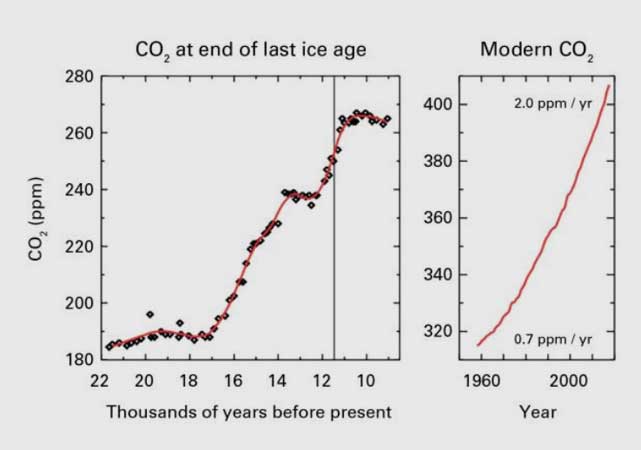Greenhouse gas concentrations surge to new record
Concentrations of carbon dioxide in the atmosphere surged at a record-breaking speed in 2016 to the highest level in 800 000 years, according to the World Meteorological Organization’s Greenhouse Gas Bulletin. The abrupt changes in the atmosphere witnessed in the past 70 years are without precedent.
Globally averaged concentrations of CO2 reached 403.3 parts per million in 2016, up from 400.00 ppm in 2015 because of a combination of human activities and a strong El Niño event. Concentrations of CO2 are now 145% of pre-industrial (before 1750) levels, according to the Greenhouse Gas Bulletin.
Rapidly increasing atmospheric levels of CO2 and other greenhouse gases have the potential to initiate unprecedented changes in climate systems, leading to “severe ecological and economic disruptions,” said the report.
The annual bulletin is based on observations from the WMO Global Atmosphere Watch Programme. These observations help to track the changing levels of greenhouse gases and serve as an early warning system for changes in these key atmospheric drivers of climate change.
Population growth, intensified agricultural practices, increases in land use and deforestation, industrialization and associated energy use from fossil fuel sources have all contributed to increases in concentrations of greenhouse gases in the atmosphere since the industrial era, beginning in 1750.
Since 1990, there has been a 40% increase in total radiative forcing – the warming effect on our climate – by all long-lived greenhouse gases, and a 2.5% increase from 2015 to 2016 alone, according to figures from the US National Oceanic and Atmospheric Administration quoted in the bulletin.
“Without rapid cuts in CO2 and other greenhouse gas emissions, we will be heading for dangerous temperature increases by the end of this century, well above the target set by the Paris climate change agreement,” said WMO Secretary-General Petteri Taalas. “Future generations will inherit a much more inhospitable planet, “ he said.
“CO2 remains in the atmosphere for hundreds of years and in the oceans for even longer. The laws of physics mean that we face a much hotter, more extreme climate in the future. There is currently no magic wand to remove this CO2 from the atmosphere,”said Mr Taalas.
The last time the Earth experienced a comparable concentration of CO2 was 3-5 million years ago, the temperature was 2-3°C warmer and sea level was 10-20 meters higher than now.
The WMO Greenhouse Gas Bulletin reports on atmospheric concentrations of greenhouse gases. Emissions represent what goes into the atmosphere. Concentrations represent what remains in the atmosphere after the complex system of interactions between the atmosphere, biosphere, cryosphere and the oceans. About a quarter of the total emissions is taken up by the oceans and another quarter by the biosphere, reducing in this way the amount of CO2 in the atmosphere.
A separate Emissions Gap Report by UN Environment, to be released on 31 October, tracks the policy commitments made by countries to reduce greenhouse gas emissions and analyses how these policies will translate into emissions reductions through 2030, clearly outlining the emissions gap and what it would take to bridge it.
“The numbers don’t lie. We are still emitting far too much and this needs to be reversed. The last few years have seen enormous uptake of renewable energy, but we must now redouble our efforts to ensure these new low-carbon technologies are able to thrive. We have many of the solutions already to address this challenge. What we need now is global political will and a new sense of urgency,” said Erik Solheim, head of UN Environment.
Together, the Greenhouse Gas Bulletin and Emissions Gap Report provide a scientific base for decision-making at the UN climate change negotiations, which will be held from 7-17 November in Bonn, Germany.
WMO, UN Environment and other partners are working towards an Integrated Global Greenhouse Gas Information System to provide information that can help nations to track the progress toward implementation of their national emission pledges, improve national emission reporting and inform additional mitigation actions. This system builds on the long-term experience of WMO in greenhouse gas instrumental measurements and atmospheric modelling.
WMO is also striving to improve weather and climate services for the renewable energy sector and to support the Green Economy and sustainable development. To optimize the use of solar, wind and hydropower production, new types of weather, climate and hydrological services are needed.
Key findings of the Greenhouse Gas Bulletin – Read more









